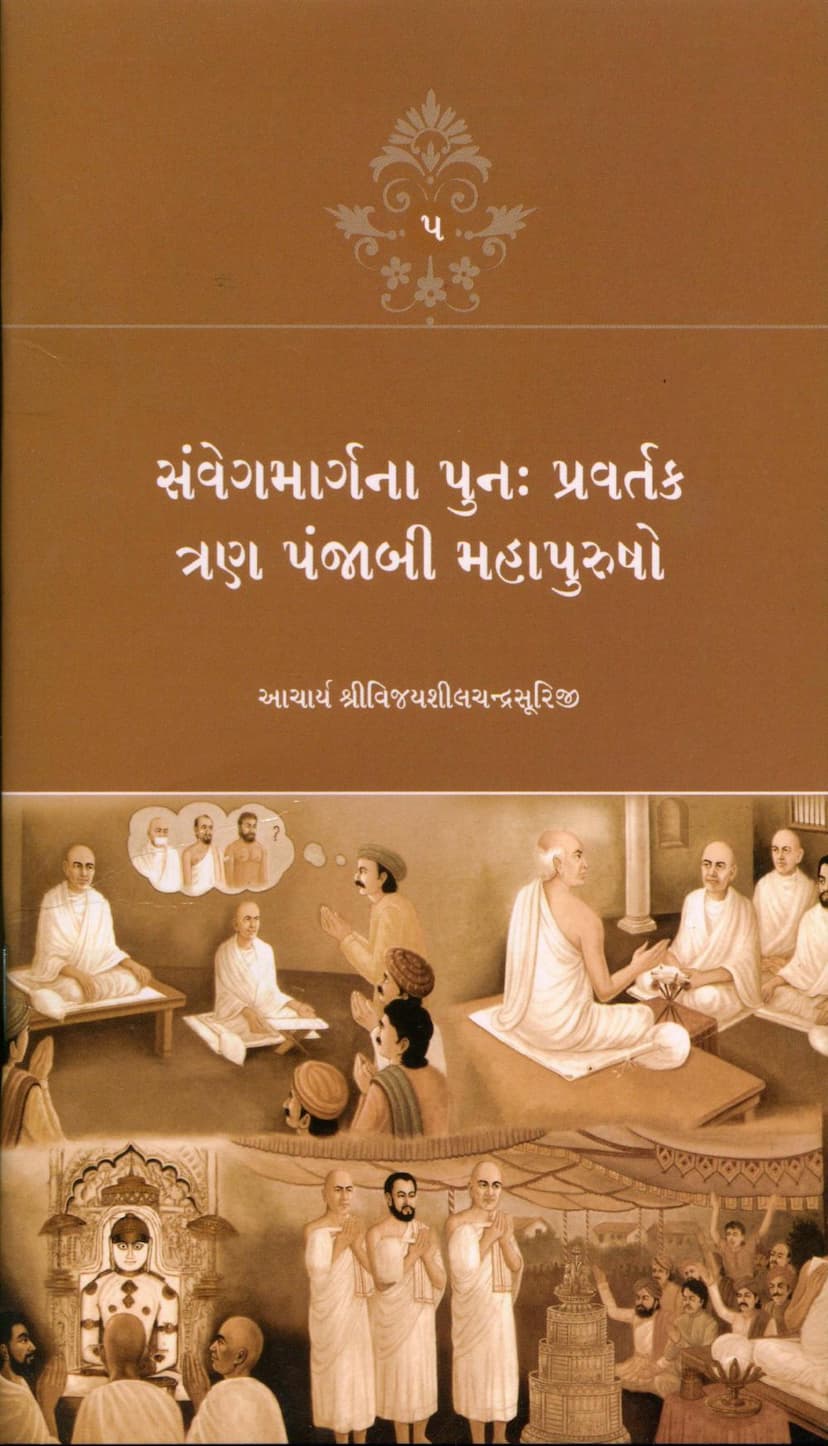Samveg Margna Punaha Pravartak Tran Punjabi Mahapurusho
Added to library: September 2, 2025

Summary
Here is a comprehensive summary in English of the Jain text "Samveg Margna Punaha Pravartak Tran Punjabi Mahapurusho" by Acharya Shri Vijayashilchandra Suriji:
This book, "Samveg Margna Punaha Pravartak Tran Punjabi Mahapurusho" (The Re-establisher of the Path of Renunciation: Three Punjabi Great Men), published by Shri Bhadrakaroday Shikshan Trust, is a collection of discourses by Acharya Shri Vijayashilchandra Suriji. The discourses were delivered in Sabarmati, Ahmedabad on January 3, 2016, and are part of the "Shasan Samrat Bhavan Granthmala" series, specifically the second volume of the "Gurugungaanmay Pravachanmala" (Discourses Glorifying the Qualities of Gurus).
The central theme of the book is to highlight the crucial role of Gurus in upholding and propagating the Jain faith, particularly in the absence of Tirthankaras. The Acharya explains that the Jain tradition has a lineage of spiritual guides, tracing back to Sudharmaswami and the establishment of various Gacchas (sects or traditions) and Kul (lineages). He details how these traditions, though having different names and organizational structures (like branches and schools), ultimately stem from the same core principles and lineage.
The text then delves into the history of the Tapagaccha, originating from the Vadagaccha. It mentions prominent figures like Jagatchandrasuri, whose immense tapasya earned him the title "Tapadhari" from the Rana of Chittor, transforming the Vadagaccha into the Tapagaccha. The Acharya lists several other significant luminaries of the Tapagaccha, such as Devsundarsuri, Somnumsundarsuri, and Munisundarsuri (known for his thousandfold capacity of recall and potent stotras that quelled epidemics). He also mentions Laxmisagarsuri, Hemvimalsuri, Anandvimalsuri, Dansuri Dada, Hiravijaysuri Dada, and Vijayensuri, among others, emphasizing their purity and unwavering devotion.
A significant portion of the book discusses a period of decline and conflict within the Tapagaccha, particularly after Vijaydevsuri. This era, lasting about 150-200 years, saw the rise of the Yati tradition, which held significant authority and control over the Gaccha. This led to a dilution of the strict practices and the "Samveg Marg" (Path of Renunciation and Spiritual Urgency). The Acharya explains how the Yati system exerted immense power, controlling the lives and movements of monks.
The narrative then focuses on the critical need to revive the Samveg Marg. During the latter half of the 19th century, the Tapagaccha in Gujarat and Rajasthan was in a weakened state, with a limited number of Samveg-oriented monks. The situation was dire, described as "mandprana" (weak-hearted or low-spirited). In this context, the book introduces three Punjabi Mahapurushas who were instrumental in reviving the Samveg Marg.
These three individuals were originally followers of the Sthanakvasi sect:
- Buterayji Maharaj (later Buddhivijayji): Born in 1863 in Punjab, he renounced worldly life at the age of 15. After searching for a true spiritual path for 10 years, he was initiated into the Sthanakvasi tradition by Rishi Nagarmalji in 1888. Initially, he faced internal conflict regarding practices like the use of the muhapatti (mouth cloth) and idol worship, as his study of scriptures suggested a different path. After 10 years of struggle, he publicly advocated for the true path, facing opposition, threats, and even assassination attempts. He broke the muhapatti and advocated for idol worship.
- Moolchandji Maharaj (later Muktivijayji): He joined Buterayji in his quest and was initiated by him in 1903. Moolchandji was a scholar and a strong proponent of monastic discipline. He played a pivotal role in organizing the monastic order, introducing strict adherence to scriptures, and reviving the spirit of renunciation. He faced opposition from the Yati tradition and was instrumental in challenging their authority, leading to significant shifts in the community's practices. He is credited with increasing the number of monks dramatically, establishing a "Deeksha Yug" (era of initiation).
- Vriddhichandji Maharaj (later Vriddhivijayji): Initiated in 1904, he was a strong pillar of the revival movement. He demonstrated immense dedication and adherence to the principles of renunciation. An incident involving accidentally consuming salt in milk highlighted his commitment to purity and the strictness of the monastic code. He later established a tradition in Bhavnagar, nurturing scholars and devotional disciples.
The book details their journey, their scholarly pursuits, their debates with other Jain sects (like the Trigutik mata), and their firm stance against what they perceived as laxity and deviations from the core Jain principles. They actively promoted the correct understanding of scriptures, the importance of strict adherence to vows, and the revival of the spirit of renunciation and detachment.
The text emphasizes the profound discipleship and mutual respect between these three figures and their guru, Buterayji. It also highlights their influence on other prominent monks like Atmaramji Maharaj, who, despite being granted Acharya status, declared himself a disciple of Moolchandji. The book also touches upon the challenges they faced from societal and traditional authorities, and how they navigated these through their unwavering faith and scriptural knowledge.
Ultimately, the book serves as a testament to the enduring power of the Samveg Marg and the transformative impact of sincere spiritual guidance. It celebrates the courage and conviction of these three Punjabi Mahapurushas who revitalized the Jain faith during a critical period, ensuring the continuity of the true path of renunciation for future generations. The book concludes with a call for readers to strive to keep this spiritual stream alive and flowing.